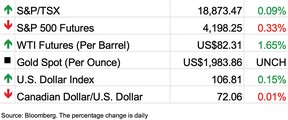Posthaste: These three provinces are the best places to weather Canada’s coming storm

Once again, commodities are key

Article content

Article content
GDP data out yesterday confirmed that Canada’s economy is teetering on the brink of recession — but if you think 2023 was bad, brace yourself for 2024.
As the sharp rise in the Bank of Canada’s interest rates continues to apply its brakes on the economy, economists predict more pain to come.
Canada’s real GDP growth is expected to flatline at 0.1 per cent in 2024 from 1.1 per cent this year, according to a recent Desjardins forecast.
Advertisement 2
Story continues below
Article content
Most provinces will see growth slow, but some more than others — and commodities will be key for avoiding the worst of the downturn, said the report by Desjardins economists Marc Desormeaux and Hélène Bégin.
Alberta, Saskatchewan and Newfoundland and Labrador are best positioned to weather the storm, it said.
Alberta’s economy will lead growth in Canada next year at 1 per cent, according to their forecast. Oil prices are high and output looks set for a rebound in 2024, with plans to ramp up production in coming years.
New export capacity when the Trans Mountain Pipeline expansion comes on line later this year should narrow the existing discount between Alberta and American oil prices.
Uranium production is expected to continue to rise in Saskatchewan following the restart of McArthur River and Cigar Lake mines, says the report. This week Australian mining giant BHP Group Ltd also announced it is going ahead with a plan to spend $6.4 billion to build the second stage of its Jansen potash mine east of Saskatoon.
Weakness in oil production has dragged on Newfoundland and Labrador’s economy in recent years, but Desjardins expects output to pick up in 2024. Activity is ramping up at White Rose field and there is potential for resumption of operations at Terra Nova, which has been offline since 2020. There are also some major projects in the works including the West White Rose offshore oilfield extension and the Voisey’s Bay underground mine.
Article content
Advertisement 3
Story continues below
Article content

Then there is Ontario.
This province’s growth beat the national average in the first half of 2023, thanks in part to the strongest population surge in 50 years. The housing market sprang back to life in the spring after the Bank of Canada paused interest rate hikes and car production rebounded, lifting exports.
But its outlook is dimmer. In Ontario and British Columbia, the housing market is a big part of the economy and households are more indebted, making them the most vulnerable to the effects of a sharp rise in interest rates.
The economies of these two provinces are the only two in Desjardins’ forecast to contract in 2024. Ontario’s real GDP is expected to shrink to -0.1 per cent from 1.2 per cent in 2023 and British Columbia’s is seen falling to -0.1 per cent from 0.7 per cent.
_____________________________________________________________________
Was this newsletter forwarded to you? Sign up here to get it delivered to your inbox.
_____________________________________________________________________


Canada’s economy has been stuck in stall (or worse) for the past seven months, GDP data revealed yesterday, and given that the country has yet to feel the full impact of interest rate hikes, there is more downside to come, says BMO strategist Benjamin Reitzes.
Advertisement 4
Story continues below
Article content
Statistics Canada said Tuesday that gross domestic product flatlined in August, and early estimates for September also showed no growth. The numbers confirm for many economists that the country is already in a modest technical recession (two consecutive quarters of contraction).
“This is yet one more crystal clear sign that the Bank of Canada should be done hiking,” said Reitzes.
- Federal Reserve’s FOMC makes interest rate announcement at 2 p.m. today followed by a press conference with chair Jerome Powell at 2:30 p.m.
- Bank of Canada governor Tiff Macklem and senior deputy governor Carolyn Rogers appear before the Senate banking, commerce and economy committee
- Today’s Data: S&P Global Manufacturing PMI, U.S. construction spending, job openings and labor turnover survey
- Earnings: Canada Goose, Lundin Mining, Cogeco Communications, Nutrien

_______________________________________________________
Advertisement 5
Story continues below
Article content
If you’ve never been hit by a curve ball big enough to force you to take a hard look at your financial habits, consider the current cost of living crisis as your warning. Debt counsellor Sandra Fry checks off some money habits that could allow you to break the cycle of feeling like you never have quite enough.
Related Stories
____________________________________________________
Today’s Posthaste was written by Pamela Heaven, @pamheaven, with additional reporting from The Canadian Press, Thomson Reuters and Bloomberg.
Have a story idea, pitch, embargoed report, or a suggestion for this newsletter? Email us at [email protected], or hit reply to send us a note.
Bookmark our website and support our journalism: Don’t miss the business news you need to know — add financialpost.com to your bookmarks and sign up for our newsletters here.
Article content










Comments
Postmedia is committed to maintaining a lively but civil forum for discussion and encourage all readers to share their views on our articles. Comments may take up to an hour for moderation before appearing on the site. We ask you to keep your comments relevant and respectful. We have enabled email notifications—you will now receive an email if you receive a reply to your comment, there is an update to a comment thread you follow or if a user you follow comments. Visit our Community Guidelines for more information and details on how to adjust your email settings.